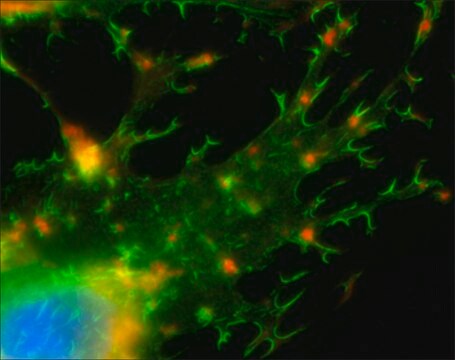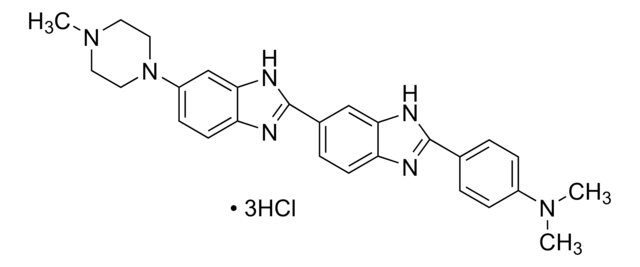D9542
DAPI
for nucleic acid staining
Synonim(y):
4′,6-Diamidino-2-phenylindole dihydrochloride, 2-(4-Amidinophenyl)-6-indolecarbamidine dihydrochloride, DAPI dihydrochloride
About This Item
klasa czystości
for molecular biology
Poziom jakości
Próba
≥98% (HPLC)
Postać
powder
metody
transfection: suitable
rozpuszczalność
H2O: 20 mg/mL (heat or sonication may be required. Solutions stored in the dark at room temperature or 4 °C should be stable for 2 to 3 weeks.)
PBS: insoluble
ε (współczynnik ekstynkcji)
30 at 263 nm in H2O at 1 mM
fluorescencja
λex 340 nm; λem 488 nm (nur DAPI)
λex 364 nm; λem 454 nm (DAPI-DNA-Komplex)
przydatność
suitable for fluorescence
temp. przechowywania
2-8°C
ciąg SMILES
Cl.Cl.NC(=N)c1ccc(cc1)-c2cc3ccc(cc3[nH]2)C(N)=N
InChI
1S/C16H15N5.2ClH/c17-15(18)10-3-1-9(2-4-10)13-7-11-5-6-12(16(19)20)8-14(11)21-13;;/h1-8,21H,(H3,17,18)(H3,19,20);2*1H
Klucz InChI
FPNZBYLXNYPRLR-UHFFFAOYSA-N
Szukasz podobnych produktów? Odwiedź Przewodnik dotyczący porównywania produktów
Powiązane kategorie
Opis ogólny
Zastosowanie
- DNA staining in agarose gels
- analysis of changes in DNA during apoptosis
- detection of mycoplasma
- photofootprinting of DNA
- immunofluorescent staining of cells
DAPI has been used:-
- in rapid monitoring of microbial contamination
- in chromosomal banding technique
- in detection of apoptotic cells
- in fluorescence microscopy to track the DisA (DNA integritiy scanning protein) movement on Bacillus subtilis DNA
- to stain mature pollen grains(0.5 mg/ml)
Działania biochem./fizjol.
Przestroga
Hasło ostrzegawcze
Warning
Zwroty wskazujące rodzaj zagrożenia
Zwroty wskazujące środki ostrożności
Klasyfikacja zagrożeń
Skin Irrit. 2 - Skin Sens. 1A - STOT SE 3
Organy docelowe
Respiratory system
Kod klasy składowania
11 - Combustible Solids
Klasa zagrożenia wodnego (WGK)
WGK 3
Temperatura zapłonu (°F)
Not applicable
Temperatura zapłonu (°C)
Not applicable
Środki ochrony indywidualnej
Eyeshields, Gloves, type N95 (US)
Certyfikaty analizy (CoA)
Poszukaj Certyfikaty analizy (CoA), wpisując numer partii/serii produktów. Numery serii i partii można znaleźć na etykiecie produktu po słowach „seria” lub „partia”.
Masz już ten produkt?
Dokumenty związane z niedawno zakupionymi produktami zostały zamieszczone w Bibliotece dokumentów.
Klienci oglądali również te produkty
Produkty
Regulation of the cell cycle involves processes crucial to the survival of a cell, including the detection and repair of genetic damage as well as the prevention of uncontrolled cell division associated with cancer. The cell cycle is a four-stage process in which the cell 1) increases in size (G1-stage), 2) copies its DNA (synthesis, S-stage), 3) prepares to divide (G2-stage), and 4) divides (mitosis, M-stage). Due to their anionic nature, nucleoside triphosphates (NTPs), the building blocks of both RNA and DNA, do not permeate cell membranes.
The Comet Assay, also called single cell gel electrophoresis (SCGE), is a sensitive and rapid technique for quantifying and analyzing DNA damage in individual cells.
Dostępne procedury, odczynniki i sprzęt do fluorescencyjnej hybrydyzacji in situ (FISH).
Available Fluorescent in situ hybridization (FISH) procedures, reagents and equipment.
Protokoły
Immunocytochemistry (ICC) Cell Capture Imaging Reagent and protocol for eliminating wash steps, and is highly effective in applications involving rare cells, low cell count samples, and limited access samples.
Powiązane treści
Three-dimensional (3D) printing of biological tissue is rapidly becoming an integral part of tissue engineering.
Trójwymiarowe (3D) drukowanie tkanek biologicznych szybko staje się integralną częścią inżynierii tkankowej.
Nasz zespół naukowców ma doświadczenie we wszystkich obszarach badań, w tym w naukach przyrodniczych, materiałoznawstwie, syntezie chemicznej, chromatografii, analityce i wielu innych dziedzinach.
Skontaktuj się z zespołem ds. pomocy technicznej






